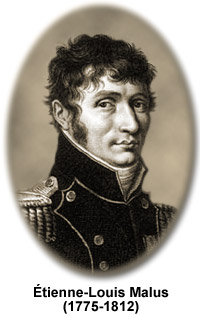Étienne-Louis Malus
(1775-1812)

Étienne-Louis Malus was born in Paris, France and displayed significant ability in mathematics while attending the military engineering school at Mezires. He was dismissed from the establishment, however, without a commission in 1793 on political grounds. Subsequently, Malus entered the French army as a private soldier and eventually gained notice for his skills, which resulted in his superiors selecting him to study at the École Polytechnique. A pupil of Jean-Baptiste-Joseph Fourier, while enrolled at the state supported institution Malus began carrying out research in optics focusing upon the refractive indices of various materials. Once he received his degree, Malus was accepted into the army’s corps of engineers, but remained associated with the École Polytechnique as an examiner. Malus took part in Napoleon’s campaigns in Egypt and Syria in 1798 and did not leave the region until 1801.
Although he continued to hold official posts in the military for many years, Malus became increasingly involved in the study of optics following his return from the East. In 1807, he commenced experiments on double refraction, the phenomenon that causes a light beam to divide into two different rays on passing through certain materials, such as Iceland spar. Malus’s findings supported those obtained earlier by Dutch scientist Christiaan Huygens, whose description of double refraction was founded upon the then controversial idea that light is characteristically wavelike. In 1808, Malus famously discovered that light could be polarized (a term coined by Malus) by reflection as he observed sunlight reflected from the windows of the Luxemburg Palace in Paris through an Iceland spar crystal that he rotated. He followed the discovery with additional experiments, which demonstrated that the capacity to polarize light was not limited to Iceland spar and other special types of crystals, but that the reflections from most ordinary substances could also produce the effect. Malus’s work on polarization was published in 1809, and in 1810, his theory of double refraction of light in crystals appeared in print as well.
Included among Malus’s published work is Malus’s law, a mathematical means of predicting the intensity of light transmission through a pair of polarizing filters. The equation, which is a function of the angles between the polarizer transmission axes, is usually written as follows:
where I is the intensity of light passing through the analyzer (and the total amount of light passed through the pair of crossed polarizers), I(0) is the intensity of light that is incident upon the polarizer, and q is the angle between the transmission axes of the polarizer and analyzer. Using this equation, it can be determined, for instance, that when the two polarizers are crossed (q = 90 degrees), the intensity is zero, meaning that all light passed by the polarizer is completely extinguished by the analyzer.
For his groundbreaking efforts in optics, Malus was honored with many awards. Most notably he received the accolades of the French Académie des Sciences, to which he was elected as a member soon after his double refraction research, and the Rumford medal of the Royal Society of London, a surprising tribute since France and England were at war at the time. Despite his great potential for additional contributions to the field of optics, Malus’s life ended prematurely soon after his most famous discoveries, on February 23, 1812. He reportedly succumbed to an illness, possibly tuberculosis, that he contracted many years earlier while on a military campaign.
